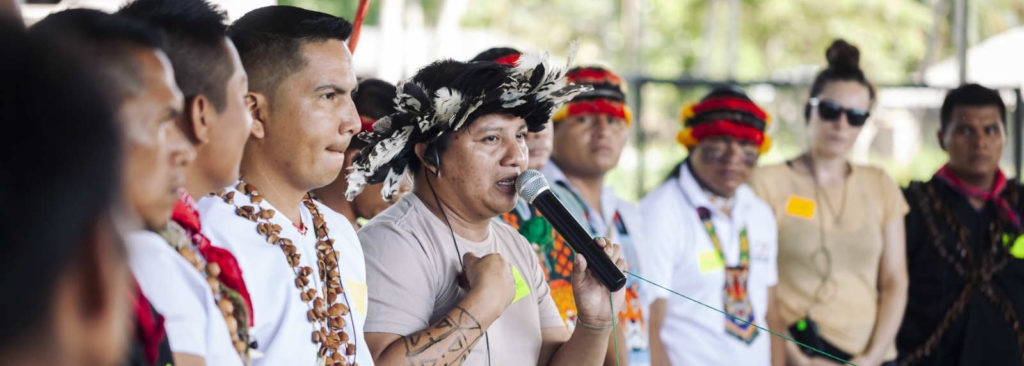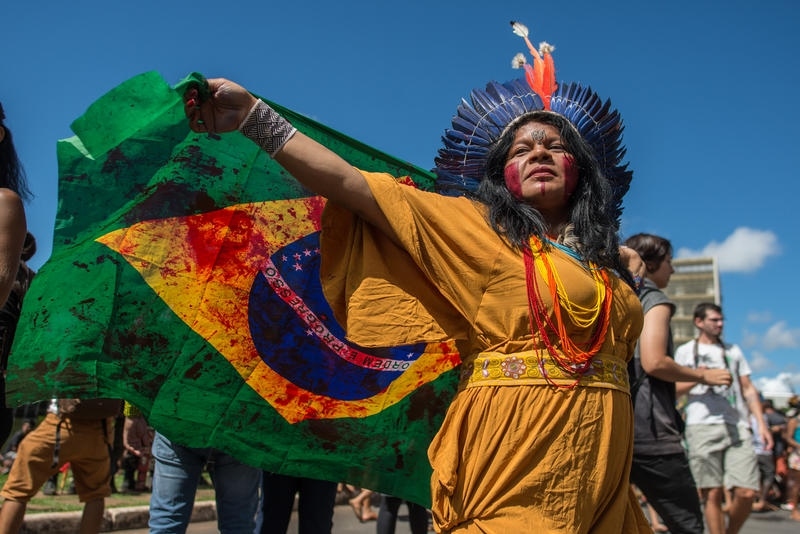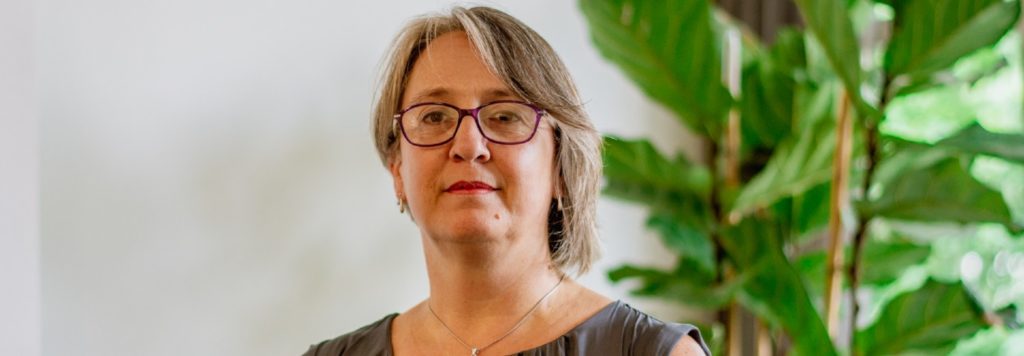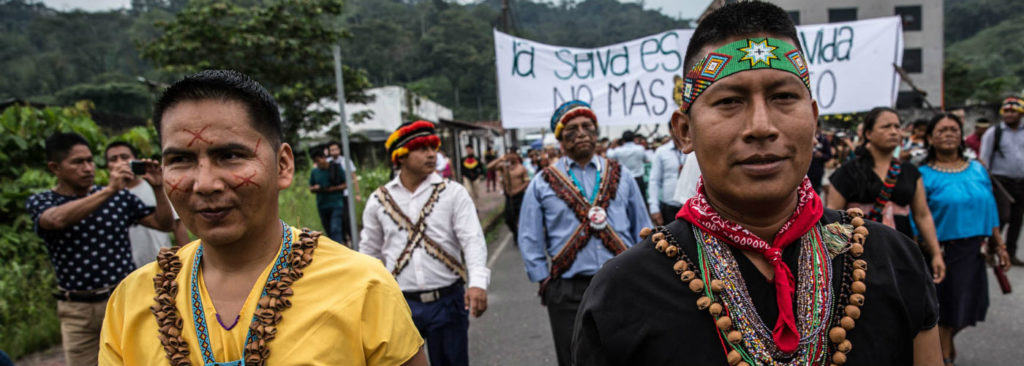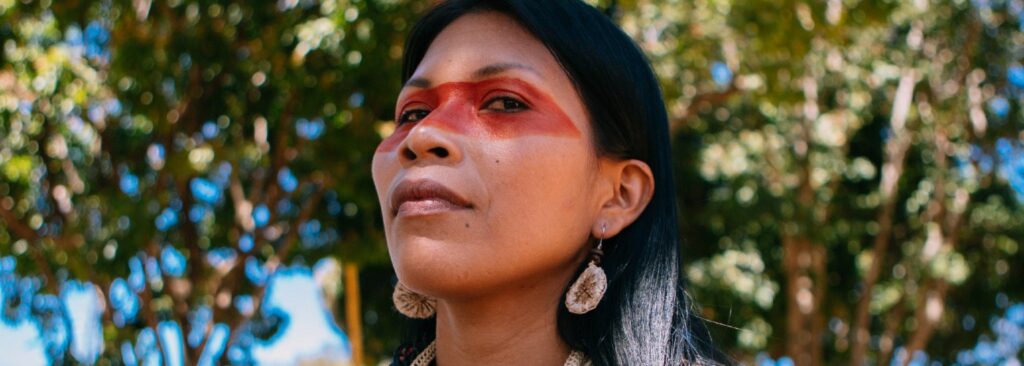Written by Paula Bernardi (Country Coordinator Brazil) and Daniel Torre (Monitoring and Evaluation Coordinator)
Deforestation and lack of protection are doubling the vulnerability of Indigenous Peoples and local communities
The COVID-19 pandemic has made one thing very clear: we are all connected. The outbreak is confronting us worldwide with health risks and changes in our social behavior. While the final effects of the virus are still unknown, it is clear this crisis will disrupt lives everywhere. This is particularly true for the Indigenous Peoples and local communities in the Amazon, a region that has become increasingly more accessible because of deforestation and the push for natural resource extraction. The following is an update from our All Eyes on the Amazon program in Brazil, Ecuador and Peru.
Indigenous Peoples at risk
In the Amazon forest, Indigenous Peoples and local communities were already facing constant major threats: human rights violations, deforestation, ecosystem degradation, and the extraction of natural resources. Now they have to deal with the effects of the COVID-19 pandemic and its associated response measures. The Organization of American States stated that Indigenous populations face a situation of double vulnerability due to their historical marginalization and geographic isolation, and urged authorities to protect the health and well-being of their Indigenous populations.
But this is not happening now, nor was it happening before the COVID-19 outbreak. Governments in the Amazon region have largely neglected their duties to provide overall security and enforce laws to protect Indigenous territories. There are no public policy agendas to maintain Indigenous Peoples’ cultural and social habits. And most Amazon region countries have fragile healthcare systems to start with.
So Indigenous Peoples are taking matters into their own hands and adopting self-isolation as a protection against COVID-19. This is crucial given Indigenous Peoples’ low immunity to infectious diseases. Historically, respiratory and infectious diseases like the common flu have been one of their greatest threats. If visitors from outside or inter-village travelers bring the flu virus to indigenous territories, further transmission goes very fast.
Lack of adequate government measures
Latin American governments are either not considering, not equipped or not able to take into account the vulnerabilities of Indigenous Peoples in contingency plans to tackle the crisis. Pandemic-related measures like quarantines and lockdowns only increase the existing difficulties of geographic dispersion. They also negatively affect indigenous economies and traditional livelihoods, and limit access to already hard to reach goods and services.
But public organizations are neither financially nor structurally prepared to deal with emergency healthcare efforts and food security challenges. So the result could be catastrophic for many communities. At the same time, environmental policies and actions have been put on the backburner, causing additional risks for Indigenous peoples and their habitat: the rainforest.
In the midst of the emergency, land grabbers, loggers and miners have not stopped invading the forest and are now opportunistically committing criminal activities that destroy it. As Brazil, for example, scales back environmental protection efforts because of the coronavirus outbreak, environmentalists expect that deforestation from/or caused by illegal mining, illegal logging, and agriculture and livestock activities will continue to rise. With the added risk that the individuals involved may also spread COVID-19 to the local communities.
Indigenous voices
Our Indigenous partners urgently call for action. COICA (Coordination of Indigenous Organizations in the Amazon Basin) has issued a public declaration demanding national governments to implement measures to protect Indigenous Peoples, prevent infections, guarantee access to health services and food supplies, and respect the Indigenous Peoples’ land rights.
Sônia Guajajara, national coordinator of the Articulation of Indigenous Peoples from Brazil (APIB), acknowledges that “Respiratory diseases are already the main cause of death among native Brazilian populations, which makes the current pandemic especially dangerous.” There are also concerns about access to food for many Indigenous communities. They buy food in cities and depend on social programs like Bolsa Família, but are being advised to avoid traveling to prevent contagion.
Brazil
Brazilian Indigenous organizations APIB and COIAB (Coordination of Indigenous Peoples from the Brazilian Amazon) have started a communication campaign to create awareness among Indigenous students returning home after university classes were canceled. They have also initiated a collective fund-raising campaign to help buy food, medicine and hygiene products for the villages. Their main call to the Brazilian government is to provide them with additional protection against COVID-19.
Ecuador
In Ecuador, CONFENIAE (Confederation of Indigenous peoples from the Ecuadorian Amazon) has worked closely with COICA and local partners like Alianza Ceibo. They are putting together information in different languages in the form of infographics to distribute throughout the region. They have also shared information on social media, by cellphone and on the radio. However, the lack of access to the internet during the quarantine and lockdown is preventing some of this information from reaching communities.
Provincial governments in Ecuador are providing food to some indigenous communities, depending on how accessible they are. And several private initiatives have been launched to support marginalized populations, but very few target Indigenous Peoples. Fortunately, Amazon Frontlines has launched a crowdfunding initiative to collect funds worldwide for Indigenous communities in Ecuador.
Peru
AIDESEP, the most important national Indigenous People organization in Peru, has openly asked the national government to strengthen rural health centers in the Amazon region and help develop culturally appropriate health protocols and information for all Indigenous communities. They are also asking for masks, gloves and other equipment needed to combat the spread of the infection, as well as to prioritize COVID-19 testing. Meanwhile, most communities have gone into a self-quarantine after regional organizations shared a report on the state of each of their communities on March 30.
We need to take care of each other and of our planet.
We stand by the protectors of the Amazon
We continue to support our Indigenous partners in their efforts to protect the Amazon and themselves. Carolina Zambrano, All Eyes on the Amazon program director, says: “We have suspended all activities in and travel to Indigenous lands to protect local communities and prevent the disaster of spreading the virus. But we are reinforcing key ongoing activities aimed at protecting the Amazon and defending Indigenous Peoples’ rights during this crisis. We see the urgent need to strengthen local monitoring systems, promote campaigns to ensure Indigenous Peoples’ rights, and reinforce efforts towards integral security and protection. Also, in cooperation with our partners, we are responding to the health emergency in Indigenous territories to reduce the impact of the pandemic and its response measures. We need to stand by the Indigenous Peoples in the Amazon. We need to take care of each other and of our planet.”

